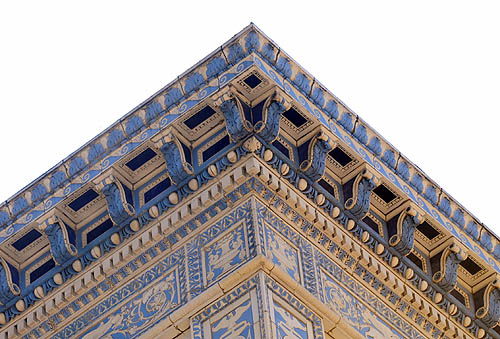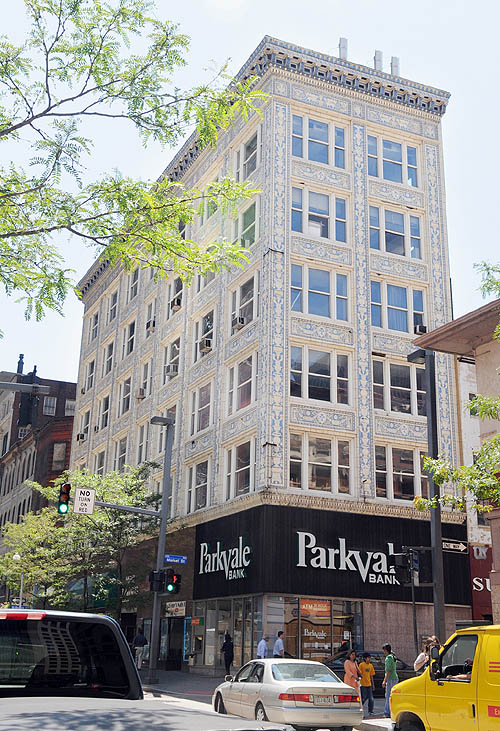
Buhl Building ready for its closeup

The Buhl Building long has been one of Downtown’s unsung background buildings, a fantasy in blue and white that you could only enjoy by craning your neck up, up, up. No more.
Since the demolition of buildings in the triangle where Fifth and Liberty avenues meet, the Buhl Building has taken on a cameo role in the Market Square city historic district. Its new visibility promises to be long-lasting because PNC, which is putting up the glass and steel tower across Fifth Avenue, won’t build on the triangle and instead will develop it as a small park.
Completed in 1913, the Buhl Building at 200 Fifth Ave. is clad in classical terra-cotta ornament, but not the usual cream-on-cream variety. The architect, Janssen & Abbott, called for blue and cream glazed tiles, and it’s a tour de force of urns, swags, plates and cartouches — a tapestry of Wedgwood Jasperware on a grand scale.
“How improbable this large-windowed but narrow six-story Renaissance Revival office tower must have seemed, covered in blue and white tile like an Italianate wedding cake in a then dark and sooty city,” former Post-Gazette art and architecture critic Donald Miller wrote in his 1997 book, “The Architecture of Benno Janssen.”
The client was Schenley Farms developer Franklin Nicola, and it was first called the Nicola Building. In the same few years, between 1909 and 1916, Janssen’s firm also was designing the Pittsburgh Athletic Association, Masonic Temple, William Penn Hotel and another terra-cotta building — a 13-story addition to Kaufmann’s department store.
By as early as 1923, the Nicola Building had a new owner — Henry Buhl Jr., partner in Boggs & Buhl department store on the North Side and founder of the Buhl Foundation. By the 1960s, if not earlier, the first-floor exterior had been renovated in dark, stark granite, so at street level there’s no hint of what we imagine was a light and lively original treatment. What a lift it must have been to walk along Fifth Avenue and see the hand of the craftsman.
But whose work was it? Were the tiles stock patterns made distinctive by the dichromatic glazing, or were they, more likely, custom-designed for the building by one of Janssen’s draftsmen? By 1909 there were about 15 makers of architectural terra cotta in the eastern United States. There’s no definitive proof in the Janssen papers at Carnegie Mellon University’s Architecture Archives, so we may never know.
A cream terra-cotta-clad building on the opposite side of Fifth Avenue, originally the Reymer’s Building, was demolished to make way for the PNC tower, so there is some karmic balance in the revelation of the Buhl Building — and more reason than ever to return its first floor to something closer to the original.
“Our intention is to remove the granite and put back the tall windows,” which were arched, said Nick Nicholas, who bought the building with Jim Patrinos in December.
The challenge is what to do with the upper floors, said Nicholas, who also owns Nicholas Coffee in Market Square.
They are considering office space or apartments or perhaps a combination of the two, but they may have to wait for the market to come to them. The Buhl Building is on the National Register of Historic Places, so the project will benefit from a 20 percent federal tax credit. The owners have given Pittsburgh History & Landmarks Foundation an easement on the facade, so it’s protected in perpetuity.
“If we restore it to a boutique building, it could be the best little boutique building Downtown, but how do we get small upscale businesses to take it?” Nicholas said. “You’ve got to almost wait until PNC and Murphy’s are done and maybe they’ll be knocking on our door for space there.”
Millcraft Industries soon will begin to convert the former G.C. Murphy Co. store into 46 apartments, a relocated YMCA and first-floor retail space.

